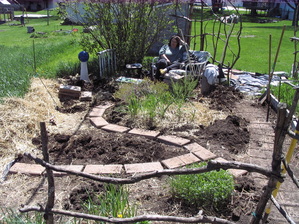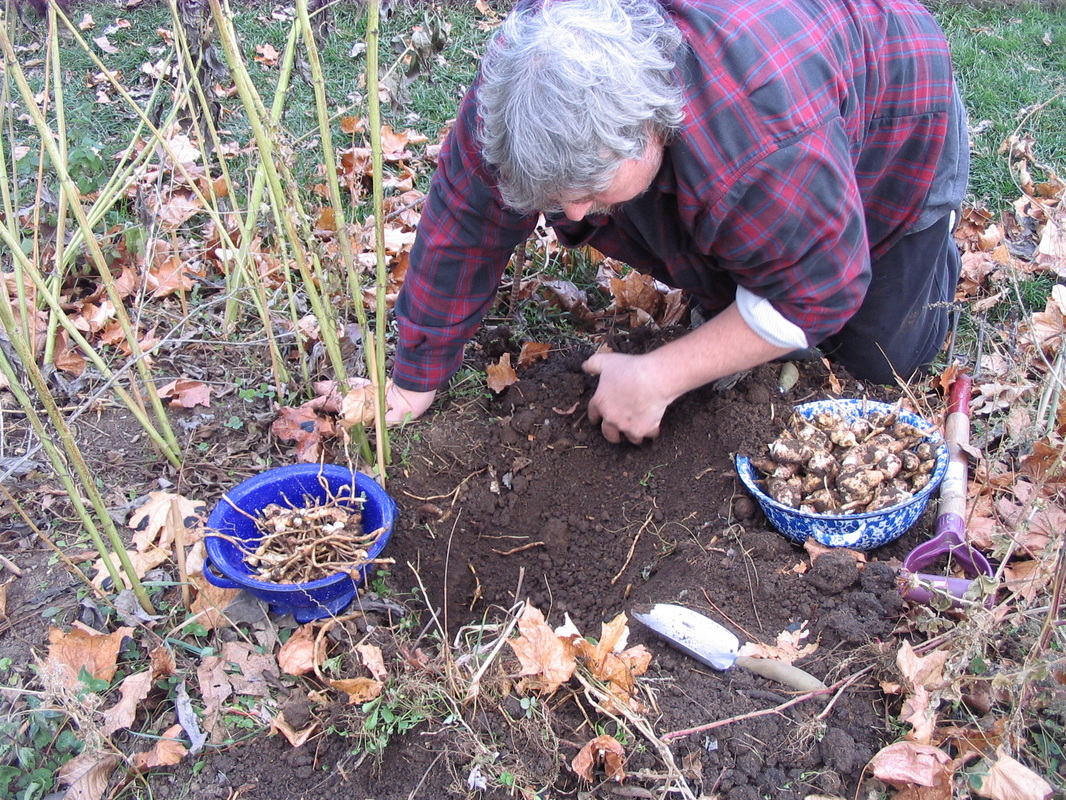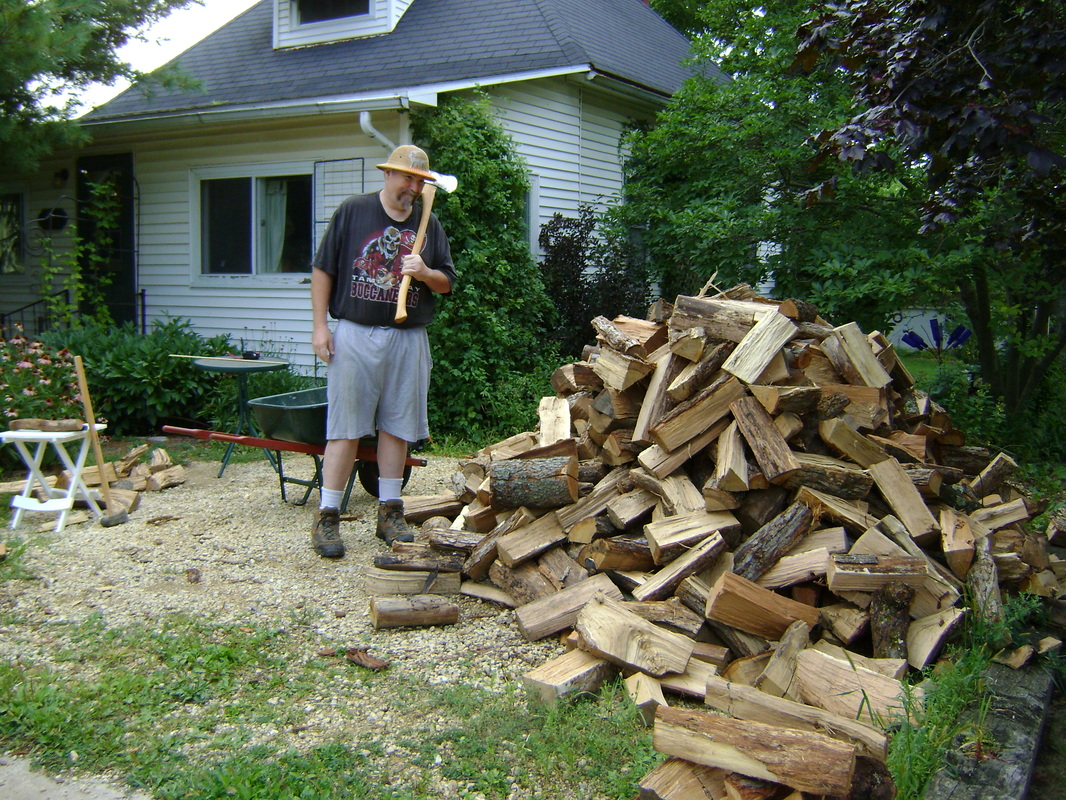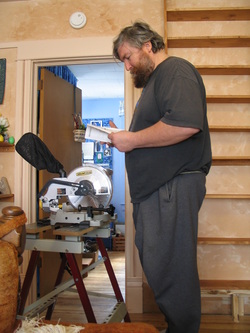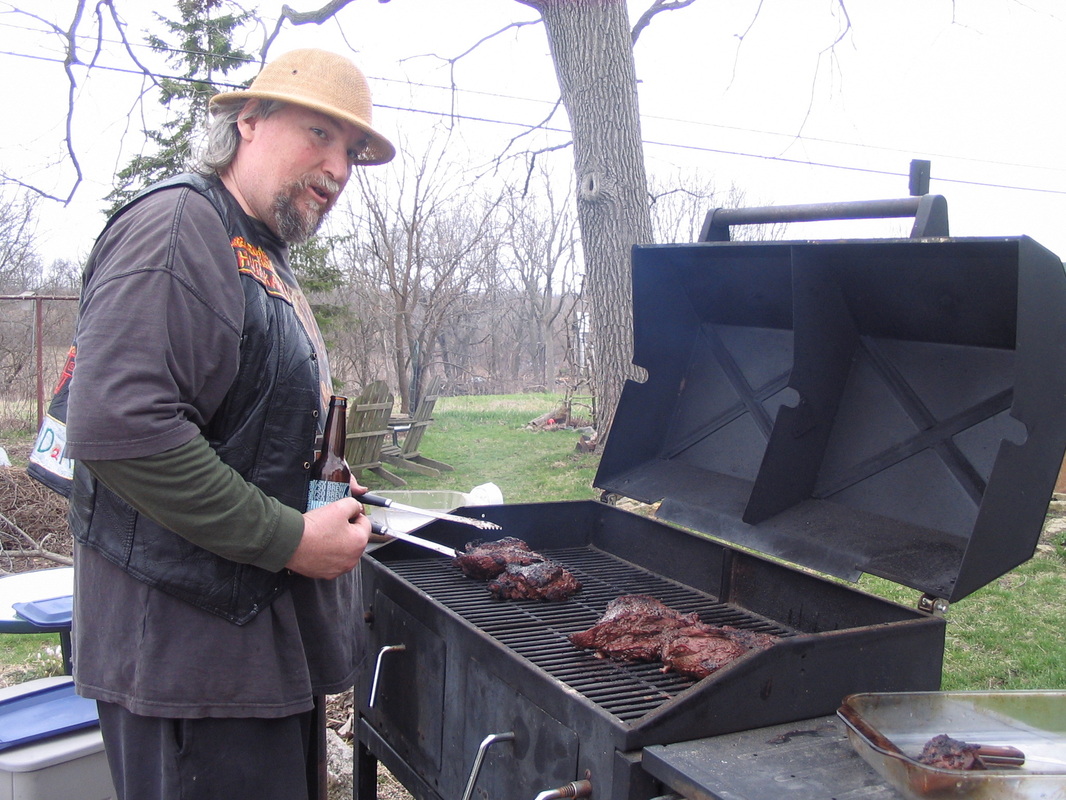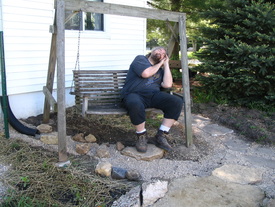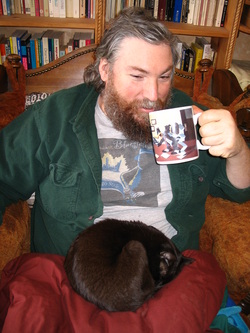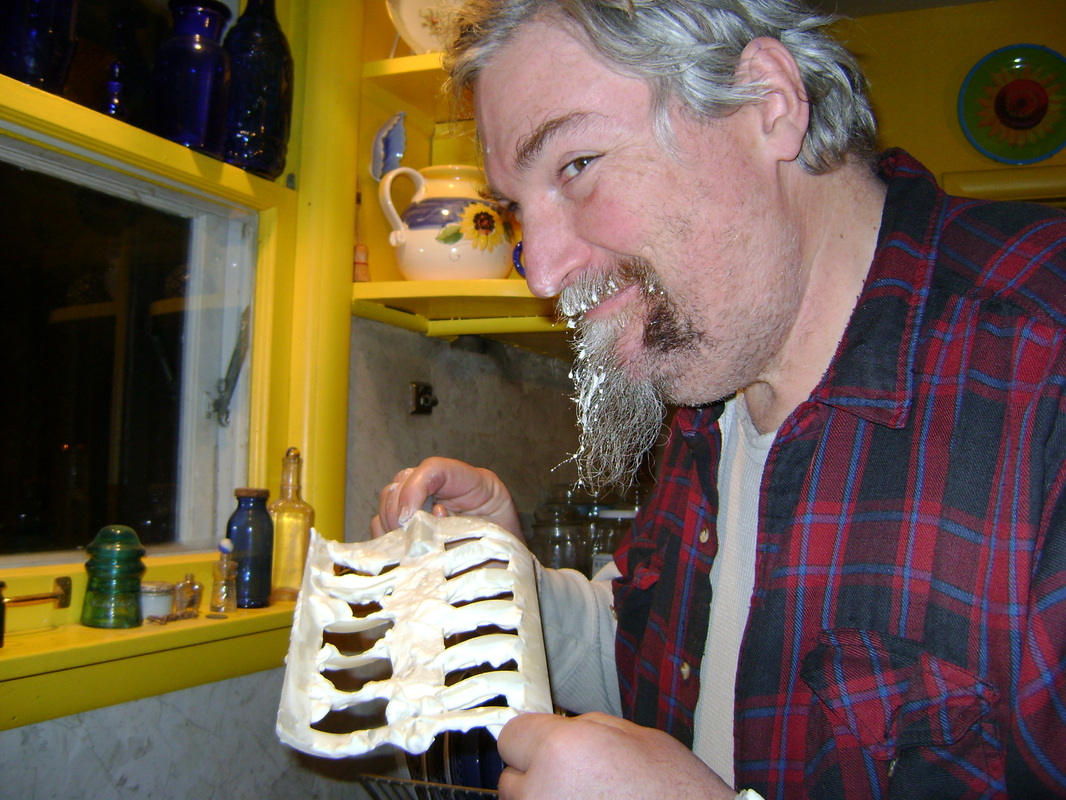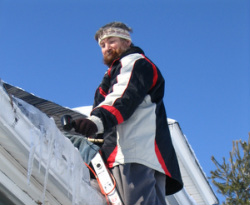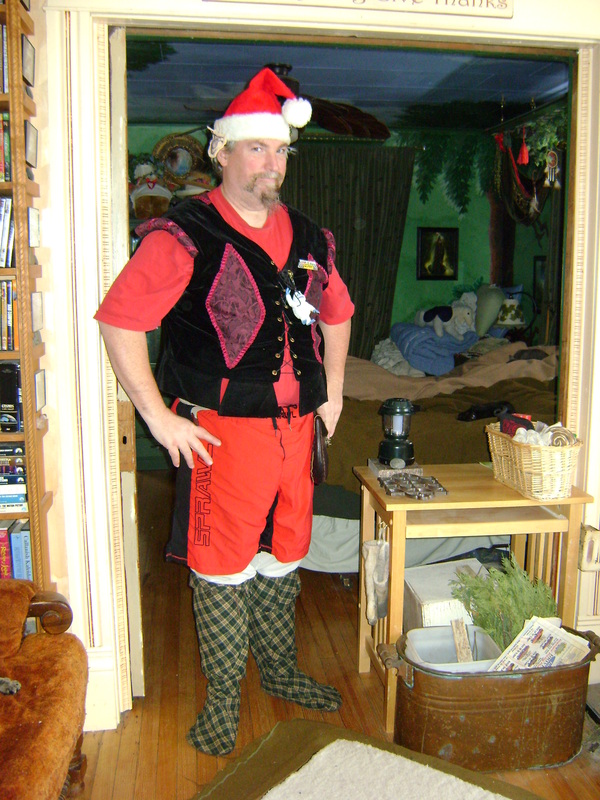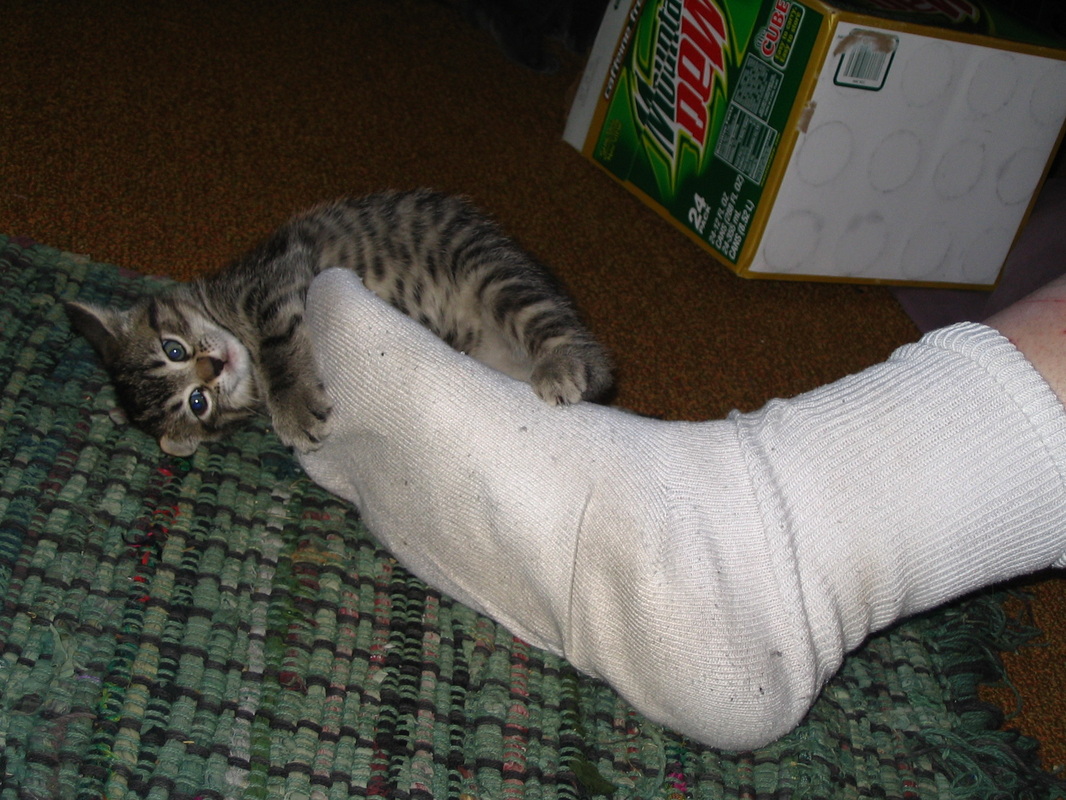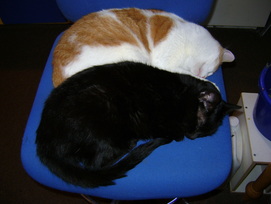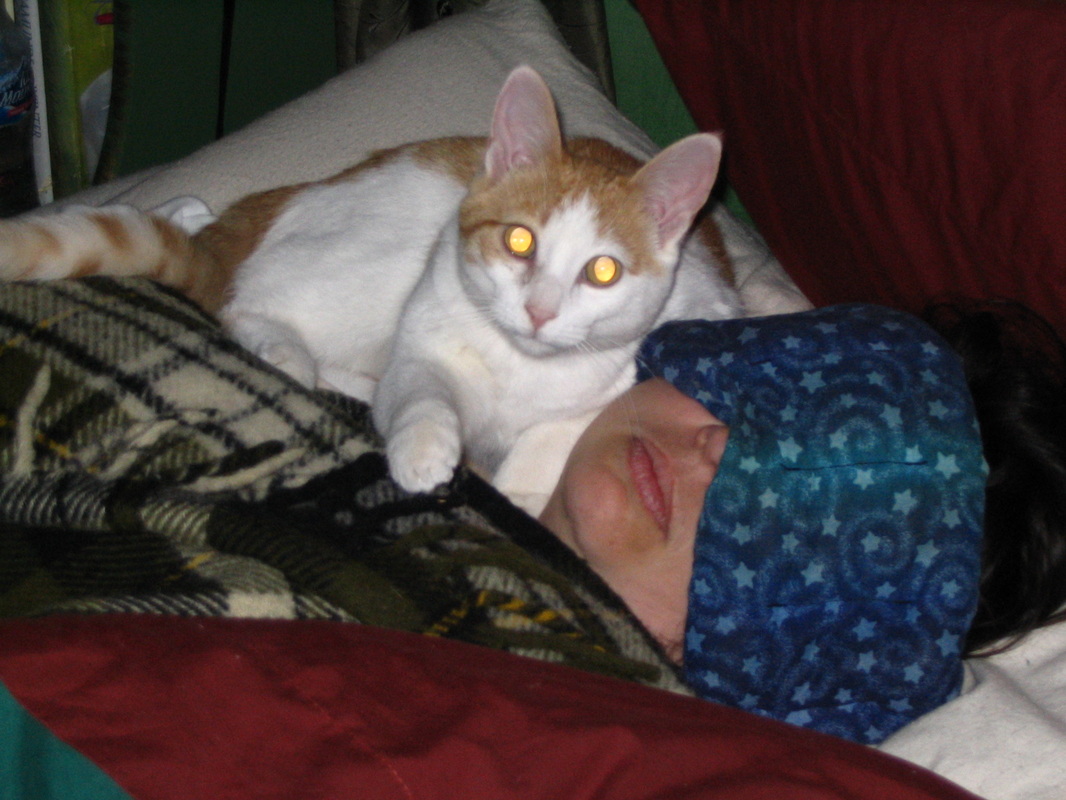ABOUT OUR TINY HOMESTEAD
Where:
We live in southwestern Wisconsin, in a small village of maybe 1000 people (less than 400 voting adults) west of Madison, Wisconsin, USA.
Climate:
|
Garden Hardiness Zone 5:
The recent update to the USDA Hardiness Zone map now puts us in Zone 5, with lows to -20° F. We were in Zone 4, with lows to -30° F. This is the best proof of global warming I’ve seen so far in my lifetime. We’ve seen both severe floods and severe drought since we moved here in 2005, and it doesn’t seem uncommon to get floods in the early Spring with drought later in the same Summer. Winters are snowy. Below freezing temperatures can last from September to March. |
Location on the Land:
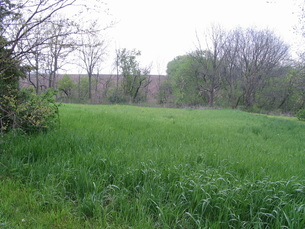 The field behind our house
The field behind our house
Our Lot: Our house is situated on a tiny lot on Main Street, 60’ across and 140’ deep, which is less than 1/8 of an acre. This includes the land that the house and our two sheds are sitting on, which doesn’t leave us much land left for feeding ourselves from the garden. The backyard is covered by two amazing black walnut trees towering three or more stories high. They give us syrup in the Spring, 10° cooler temperatures in our yard in the Summer compared to our sunny neighbor’s yards, and edible walnuts in the Fall, if we can find the energy to harvest and crack them. However, they do not leave us much sun for gardening. We have neighbors close to us on either side, but behind us are fields and a bit of woods (and the 4 lane highway you can hear when the wind is blowing from the South). Across the street from us is the Military Ridge Bike Trail, which used to be the old rail road line in this area.
When we moved in, the yard was mostly lawn, with several other trees, and some perennial flowers and hostas as foundation plantings. We have been removing more and more of the lawn each year, in order to plant a garden based on permaculture principles that will both feed us, create habitat for wildlife, and repair a bit of the damage that humans have done to the Earth’s natural environment.
Ecosystem: Our area has both flat agricultural fields that used to be oak savannah with flower filled prairie, as well as hillier, wooded areas left behind in the last Ice Age.
Watershed: The ridge on which our village is situated is the top of two watersheds. To the southeast side of the part of Main Street on which we live is the Upper East Branch of the Pecatonica River Watershed, whereas the other side is in the Mill and Blue Mounds Creek Watershed.
When we moved in, the yard was mostly lawn, with several other trees, and some perennial flowers and hostas as foundation plantings. We have been removing more and more of the lawn each year, in order to plant a garden based on permaculture principles that will both feed us, create habitat for wildlife, and repair a bit of the damage that humans have done to the Earth’s natural environment.
Ecosystem: Our area has both flat agricultural fields that used to be oak savannah with flower filled prairie, as well as hillier, wooded areas left behind in the last Ice Age.
Watershed: The ridge on which our village is situated is the top of two watersheds. To the southeast side of the part of Main Street on which we live is the Upper East Branch of the Pecatonica River Watershed, whereas the other side is in the Mill and Blue Mounds Creek Watershed.
Our House:
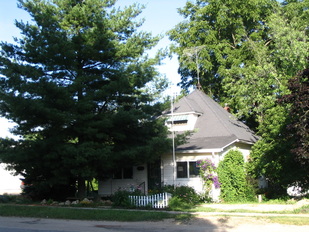
We bought what would be considered by most mainstream Americans a small house (about 1400 square feet) in 2005. We were in our late 30s, and took on a 30 year mortgage. Since we bought within our means we were very happy to pay of our mortgage early!
The house was/is a fixer upper, which is why it was in our price range. It was the first house we looked at. We loved it for its stained glass windows, quirky charm, and the lack of neighbors behind us. We assume it’s at least 100 years old (we found a check dated 1907 when we were removing walls). We renovated all the rooms with instructions from many how-to books, some assistance and advice from family, and mostly without professional help. There are only a few small projects left! We knew nothing about renovating or home ownership when we started, and pretty much bought the house as an act of faith in ourselves and the benevolence of the Universe, because we couldn’t stand apartment living anymore. We have found that we make pretty good carpenters, painters, and decorators, but not very good plumbers or electricians.
The house was/is a fixer upper, which is why it was in our price range. It was the first house we looked at. We loved it for its stained glass windows, quirky charm, and the lack of neighbors behind us. We assume it’s at least 100 years old (we found a check dated 1907 when we were removing walls). We renovated all the rooms with instructions from many how-to books, some assistance and advice from family, and mostly without professional help. There are only a few small projects left! We knew nothing about renovating or home ownership when we started, and pretty much bought the house as an act of faith in ourselves and the benevolence of the Universe, because we couldn’t stand apartment living anymore. We have found that we make pretty good carpenters, painters, and decorators, but not very good plumbers or electricians.
From Theresa:
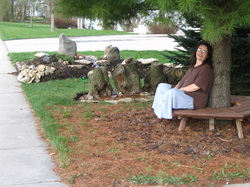
I often look back over the years and try to figure out how I got to where I am now. My mother gave me the dream of owning a home, something she was never able to do herself. I have always found that my mood is affected greatly by the energy of the space around me, and we both wanted rooms of our own that we could renovate and decorate to our satisfaction.
I have also waited most of my adult life to “own” land so that I could garden and connect with Nature in my own back yard. I grew up in a beautiful natural area in northern Michigan and learned to love Nature while camping, roaming the woods, and meditating on the shores of the many lakes in our area. I’m told both of my grandfathers were great gardeners, and some of my earliest and fondest memories are of growing flowers and harvesting vegetables.
I became a somewhat typical homeowner and gardener for these reasons. This began to change, though, after I checked out a book from our library’s gardening display called “Gaia’s Garden” by Toby Hemenway. It caught my eye because Gaia is one name for our planet, known to some as a loving, Mother Nature like-Goddess. The blurb on the back of the book said that it was a guide to home-scale permaculture, which is “…a gardening system that combines the best features of wildlife habitat, edible landscapes, and conventional flower and vegetable gardens into a self-renewing landscape that lets Nature do most of the work.” Thus far, I had been disappointed to discover that conventional gardening seemed to be mostly about controlling Nature- encouraging the plants you want to grow and killing everything else. Permaculture offered the alternative I’d been hoping to find. It was even more appealing, though, because it turned out to be about more than gardening, it is also about creating entire sustainable communities with local economies that support humans by including us in Nature’s cycles rather than separating us from them. It is about growing food instead of lawns, but also about creating community wide systems that conserve water, use sustainable energy, and encourage community.
I was at a meeting of the Madison Permaculture Guild when I first heard about Peak Oil. Many scientists believe we have reached the peak of oil production on the planet, and that soon oil will be too expensive to harvest. Our current industrial culture is based on having had 100 years of cheap oil- not only does it fuel the cars that allow us to drive from the suburbs to our jobs in the city, it also feeds us. It is the basis of our agricultural system that is fertilized with petroleum-based products and shipped 1000s of miles in diesel fueled trucks to the shelves in our stores, which need to be restocked every three days. Running out of affordable fuel is tantamount to cultural collapse in our society, and a very frightening idea. Climate change has also pointed out how industrial societies are threatening life on the planet. Reading about Peak Oil and climate change made me want to transition to a society that was not based on fossil fuels, that respects the environment.
These influences slowly changed my urge to renovate and decorate into an urge to be as self-reliant as I can while living in a way that protects the Earth rather than harms it. There seem to be a lot of labels for what we’re doing: permaculture, homesteading, self-sufficiency, voluntary simplicity, transition initiative, sustainable living, green living, eco-living, emergency preparedness, etc. I think all of these movements have something to contribute to the improvement of industrialized civilization, and we are slowly attempting to integrate tenets from all of them into our lives.
I have a degree in anthropology from the University of Chicago, where I studied many cultures around the world. This makes me tend to see problems from a cultural perspective. I have never liked many of the basic tenets of American culture, which encourage us toward prestigious careers that make the most money possible so that we can consume more without regard for how it affects the environment. I have never forgotten learning about the Bushmen of the Kalahari Dessert (in Africa), whom we are taught to look down upon because they are subsistence level hunters and gatherers who can carry everything they own on their backs, only have to work 4 hours a day to feed and sustain themselves. This seems so much more sensible than our 8+ hour work day, followed by more hours of chores and childcare at home.
I also focused my studies on the world’s various religious systems, which to me are different expressions of our search for meaning and our yearning for personal connection with the Divine. I was most drawn to the aboriginal religions that focus on connecting to the Divine in Nature and through natural cycles. These religious systems assume that all of Nature is sacred and so their practitioners easily live in ways that don’t harm the environment.
I also have a Master’s degree in Social Work from the UW-Madison. Although I have never worked as a social worker, getting this degree was a clear expression of my need to serve others in some capacity. I am hoping this website will also help fulfill that need. At our house, we are always attempting new ways of living lightly on the Earth and celebrating Nature, and I am hoping that sharing our ideas, along with step by step instructions, will give you the inspiration to try them at your home. Together we can all choose to make small changes that will add up to a big change. In the face of unresponsive governments and uncaring bureaucracies, it is important that we all begin believing that our individual choices can save the world.
Bear is my partner and sometimes reluctant accomplice. He is usually willing to participate in my latest scheme, even if he thinks it isn’t particularly a good idea and would rather be watching Netflix. Fortunately for me, he often provides just the suggestion and/or manual labor I need to manifest a project. He loves telling people about the crazy things we try. He will hopefully add the plucky comic relief to this website, as he often does to my life.
I have also waited most of my adult life to “own” land so that I could garden and connect with Nature in my own back yard. I grew up in a beautiful natural area in northern Michigan and learned to love Nature while camping, roaming the woods, and meditating on the shores of the many lakes in our area. I’m told both of my grandfathers were great gardeners, and some of my earliest and fondest memories are of growing flowers and harvesting vegetables.
I became a somewhat typical homeowner and gardener for these reasons. This began to change, though, after I checked out a book from our library’s gardening display called “Gaia’s Garden” by Toby Hemenway. It caught my eye because Gaia is one name for our planet, known to some as a loving, Mother Nature like-Goddess. The blurb on the back of the book said that it was a guide to home-scale permaculture, which is “…a gardening system that combines the best features of wildlife habitat, edible landscapes, and conventional flower and vegetable gardens into a self-renewing landscape that lets Nature do most of the work.” Thus far, I had been disappointed to discover that conventional gardening seemed to be mostly about controlling Nature- encouraging the plants you want to grow and killing everything else. Permaculture offered the alternative I’d been hoping to find. It was even more appealing, though, because it turned out to be about more than gardening, it is also about creating entire sustainable communities with local economies that support humans by including us in Nature’s cycles rather than separating us from them. It is about growing food instead of lawns, but also about creating community wide systems that conserve water, use sustainable energy, and encourage community.
I was at a meeting of the Madison Permaculture Guild when I first heard about Peak Oil. Many scientists believe we have reached the peak of oil production on the planet, and that soon oil will be too expensive to harvest. Our current industrial culture is based on having had 100 years of cheap oil- not only does it fuel the cars that allow us to drive from the suburbs to our jobs in the city, it also feeds us. It is the basis of our agricultural system that is fertilized with petroleum-based products and shipped 1000s of miles in diesel fueled trucks to the shelves in our stores, which need to be restocked every three days. Running out of affordable fuel is tantamount to cultural collapse in our society, and a very frightening idea. Climate change has also pointed out how industrial societies are threatening life on the planet. Reading about Peak Oil and climate change made me want to transition to a society that was not based on fossil fuels, that respects the environment.
These influences slowly changed my urge to renovate and decorate into an urge to be as self-reliant as I can while living in a way that protects the Earth rather than harms it. There seem to be a lot of labels for what we’re doing: permaculture, homesteading, self-sufficiency, voluntary simplicity, transition initiative, sustainable living, green living, eco-living, emergency preparedness, etc. I think all of these movements have something to contribute to the improvement of industrialized civilization, and we are slowly attempting to integrate tenets from all of them into our lives.
I have a degree in anthropology from the University of Chicago, where I studied many cultures around the world. This makes me tend to see problems from a cultural perspective. I have never liked many of the basic tenets of American culture, which encourage us toward prestigious careers that make the most money possible so that we can consume more without regard for how it affects the environment. I have never forgotten learning about the Bushmen of the Kalahari Dessert (in Africa), whom we are taught to look down upon because they are subsistence level hunters and gatherers who can carry everything they own on their backs, only have to work 4 hours a day to feed and sustain themselves. This seems so much more sensible than our 8+ hour work day, followed by more hours of chores and childcare at home.
I also focused my studies on the world’s various religious systems, which to me are different expressions of our search for meaning and our yearning for personal connection with the Divine. I was most drawn to the aboriginal religions that focus on connecting to the Divine in Nature and through natural cycles. These religious systems assume that all of Nature is sacred and so their practitioners easily live in ways that don’t harm the environment.
I also have a Master’s degree in Social Work from the UW-Madison. Although I have never worked as a social worker, getting this degree was a clear expression of my need to serve others in some capacity. I am hoping this website will also help fulfill that need. At our house, we are always attempting new ways of living lightly on the Earth and celebrating Nature, and I am hoping that sharing our ideas, along with step by step instructions, will give you the inspiration to try them at your home. Together we can all choose to make small changes that will add up to a big change. In the face of unresponsive governments and uncaring bureaucracies, it is important that we all begin believing that our individual choices can save the world.
Bear is my partner and sometimes reluctant accomplice. He is usually willing to participate in my latest scheme, even if he thinks it isn’t particularly a good idea and would rather be watching Netflix. Fortunately for me, he often provides just the suggestion and/or manual labor I need to manifest a project. He loves telling people about the crazy things we try. He will hopefully add the plucky comic relief to this website, as he often does to my life.
From Bear:
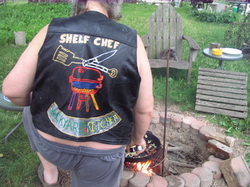
A little bit of Bear history:
Bear is all about the lazy. Bear was used to living in one room, whether on the road, with parents, or with friends who take care of the house stuff. Bear was used to eating out 110% of the time, because he really likes to eat. Bear was not used to pets. Then, Bear meets Theresa. Wow, what a ride he is in for. Bear and Theresa like each other. Bear decides his well-paying job sucks and moves to Wisconsin to live with Theresa. Bear gets many jobs there, too bad they’re all temporary. Bear, being used to having lots of money and few bills in old job, finds out world is cruel when he has no cash.
Bear learns to live with cats. Bear finds out, the more pets he gets, the more whipped he is. When dating Theresa, Bear can easily kick cats off the bed, with no guilty conscience. Now, when cats are on bed, Bear creates new yoga poses so he fits around cats without disturbing them.
Bear and Theresa find they have different living styles. Theresa’s style is- it has to be organized and look good. Bear’s style is- if it doesn't make the pile tumble over, it’s good- the top of the pile Bear uses often, the bottom stuff he’ll sort through sooner or later. For some reason, Theresa still accepts Bear’s marriage proposal, but decides she’s too crowded in apartment and wants a house. Bear is willing to go along with buying a house if he doesn’t have to do much work. Bear is a little bit naive.
Bear decides not to buy the first house looked at, but the other cheap houses suck. Bear and Theresa buy the first house. It’s a fixer upper. Bear realizes Theresa has many ideas about what to do with the property (redecorating and gardening). Bear’s laziness is somewhat distressed.
Inside, Theresa teaches Bear he can live in more than one room. Outside, Bear learns that he can do what he wants in the yard. He can dig big holes. First step, build fire pit. Bear likes the idea of a rock garden. Theresa lets Bear know that there are more than rocks that go in rock garden. Bear is disillusioned. Lazy Bear not really into plant gardening. Hungry Bear really into eating good food from garden, which surprisingly… is plants.
Bear is good at moving and lifting stuff, so Bear gets reluctantly put to work on Theresa’s projects. But when work is done, Bear gets to brag about all the cool shit he builds, telling people he is the brawn and Theresa is the brains of their creations, without saying he was kind of reluctant to build it,. Eventually, Bear thinks this activity stuff ain’t so bad.
Bear is all about the lazy. Bear was used to living in one room, whether on the road, with parents, or with friends who take care of the house stuff. Bear was used to eating out 110% of the time, because he really likes to eat. Bear was not used to pets. Then, Bear meets Theresa. Wow, what a ride he is in for. Bear and Theresa like each other. Bear decides his well-paying job sucks and moves to Wisconsin to live with Theresa. Bear gets many jobs there, too bad they’re all temporary. Bear, being used to having lots of money and few bills in old job, finds out world is cruel when he has no cash.
Bear learns to live with cats. Bear finds out, the more pets he gets, the more whipped he is. When dating Theresa, Bear can easily kick cats off the bed, with no guilty conscience. Now, when cats are on bed, Bear creates new yoga poses so he fits around cats without disturbing them.
Bear and Theresa find they have different living styles. Theresa’s style is- it has to be organized and look good. Bear’s style is- if it doesn't make the pile tumble over, it’s good- the top of the pile Bear uses often, the bottom stuff he’ll sort through sooner or later. For some reason, Theresa still accepts Bear’s marriage proposal, but decides she’s too crowded in apartment and wants a house. Bear is willing to go along with buying a house if he doesn’t have to do much work. Bear is a little bit naive.
Bear decides not to buy the first house looked at, but the other cheap houses suck. Bear and Theresa buy the first house. It’s a fixer upper. Bear realizes Theresa has many ideas about what to do with the property (redecorating and gardening). Bear’s laziness is somewhat distressed.
Inside, Theresa teaches Bear he can live in more than one room. Outside, Bear learns that he can do what he wants in the yard. He can dig big holes. First step, build fire pit. Bear likes the idea of a rock garden. Theresa lets Bear know that there are more than rocks that go in rock garden. Bear is disillusioned. Lazy Bear not really into plant gardening. Hungry Bear really into eating good food from garden, which surprisingly… is plants.
Bear is good at moving and lifting stuff, so Bear gets reluctantly put to work on Theresa’s projects. But when work is done, Bear gets to brag about all the cool shit he builds, telling people he is the brawn and Theresa is the brains of their creations, without saying he was kind of reluctant to build it,. Eventually, Bear thinks this activity stuff ain’t so bad.
The Many Faces of Bear:
Our Cats:
We don’t have any children, but we have been adopted by some lovable stray cats. They bless us with cuteness and we try to to give them a good life. They often walk across the keyboard while begging for affection, so we can blame any typos on them.
